|
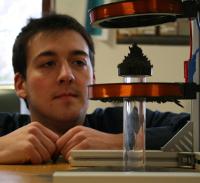
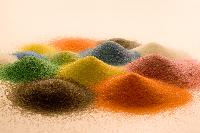
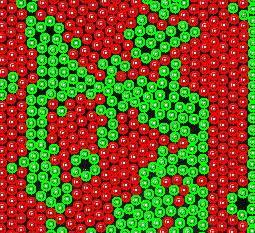
Growing of hexagonal compact domains in a granular compaction experiment.
Watch the movie
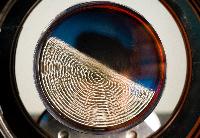
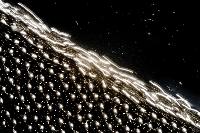
Flowing of metallic balls in a rotating drum
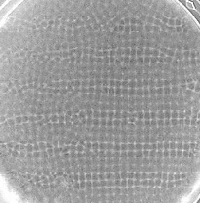
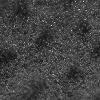
Vibrated granular layer. Watch the movie
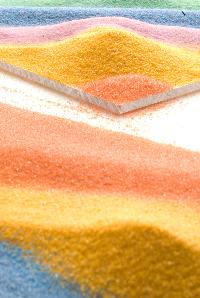
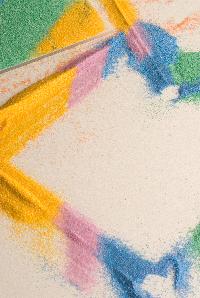
|
About me
By chance my professional activities are combining my passions for sciences and technologies.
I’m using extensively competencies in electronics, programming, and mechanics to develop original
measurement devices for research projects and to illustrate my lectures. These competencies were
mainly developed in the framework of my hobbies: DIY electronics,
aeromodelling, mechanics, blacksmithing and bladesmithing.
Position
Lectures
- General Physics (for students in pharmacy)
- Thermodynamics (for bio-engineers)
- Waves and Quanta (for engineers)
- Techniques of Experimental Physics (for students in physics)
- Numerical tools for Soft Matter Physics (for students in physics)
Some pictures of the experiments performed to illustrate my lectures:
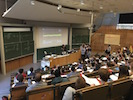




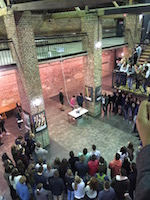
Research
Soft matter -
Cohesive granular materials -
Static, quasistatic and dynamical properties of granular materials -
Effect of a magnetic and electric field on a granular material -
Powder electrostatics -
Self Assembly processes -
Active materials -
Colloids
Research strategy - Our strategy to study a physical phenomenon is based on the development of original experimental set-ups to obtain original experimental results. Afterward, physical models are proposed to describe the physical mechanisms and to extract the main parameters. If needed, numerical simulations are conducted to investigate parameters which are difficult to control experimentally. Sometimes, laboratory prototypes developed to perform fundamental studies are becoming commercial instruments.
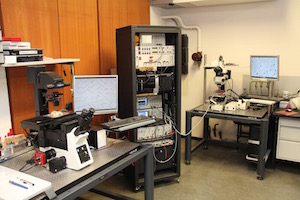
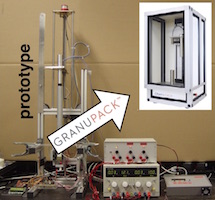
Physics of powders and granular materials. - A granular material is a conglomeration of discrete solid particles. Granular materials behavior is influenced by (1) steric repulsions, (2) friction forces (3) cohesive forces and (4) interaction with the surrounding gas. The steric repulsion is related to the grain geometry. Friction forces are influenced by both the surface state (rough or smooth surface) and the chemical nature of the grains. Cohesive forces may be induced by the presence of liquid bridges, by electrostatic charges, by van der Waals interactions or more rarely by magnetic dipole-dipole interactions. The predominance of one of these forces depends on both the environmental conditions and the physico-chemical properties of the grains. When the weight of one grain is higher than the cohesive forces, the material is considered as non-cohesive. These materials have been intensively studied during the last decades because of the rich variety of their physical properties. On the other hand, if the cohesive forces acting on a grain are higher than the weight of the grain, these cohesive forces will drastically modify the properties of the pile. Among these cohesive granular materials, fine powders are used in many research domains : chemistry, pharmacy, engineering... Nowadays, the processes used for the manipulation of powders are still mainly based on empirical knowledge. However, the complexity of the methods used in these domains induces the necessity of more rigorous knowledge of these materials. Therefore, fundamental studies of cohesive powders are still essential.
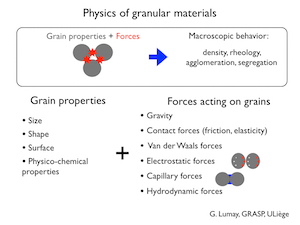
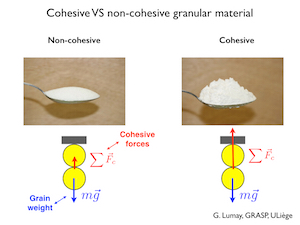
Model cohesive powders. - The difficulty to quantify and to control cohesion between the grains of a powder makes their experimental study very complex. Therefore, we first used a controlled cohesive powder made of metallic grains in an adjustable magnetic field B [18, 21]. In this controlled system, the cohesion between the grains can the tuned easily through the magnetic field. This system has been used during to study the influence of the cohesion on packing fraction, repose angle, heap shape, flow in silos and on the flow in a rotating drum.
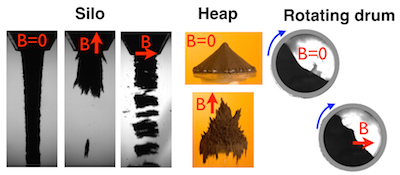
Real cohesive powders. - After the study of model cohesive powders with a fundamental approach, we analyzed (and are still analyzing) the behavior of powders used in the industry with a more practical approach [25]. For that, we developped a range of original set-ups to measure packing dynamics, powder rheology, powder electrostatic properties, cohesiveness,... At the beginning, these set-ups were laboratory prototypes. After repetitive expressions of interest from industries, these methods were adapted to become commercial laboratory instruments:
GranuFlow,
GranuPack,
GranuDrum,
GranuHeap,
GranuMidity
and GranuCharge. These instruments are now commercialized by the company GranuTools.
Combined effect of humidity and electrostatic charges on powders. - When two materials are rubbed, electric charges are exchanged at the surfaces. This contact electrification is an old fundamental scientific subject. However, despite the numerous studies dedicated to this subject, the fundamental mechanisms behind the triboelectric effect are not fully understood in powders and granular materials. The electric charges created by triboelectric effects lead to uncontrolled electric field, electrostatic forces between the grains and/or between the grains and the container. Moisture is known to affect both static and dynamic behaviors of granular materials. Moreover, the effect of moisture is far from obvious due to the interplay with electrostatic effects. Indeed, moisture influences both surface grains conductivity and capillary bridges formation. For low relative air humidity, the electrical conductivity necessary for charge dissipation is reduced. For high relative air humidity, the electrical conductivity increases and liquid bridges may be formed at the contacts between the grains, resulting in sticking. Therefore, the electrical charges are dissipated more easily. However, the apparition of liquid bridges also induces cohesive forces inside the packing. At intermediate relative humidity values the cohesion is expected to be lower. We performed different studies on that topic. In particular, we analyzed the effect of powder flow aid additives (fumed silica, mesoporous silica, stearate, ...) on these cohesive forces.
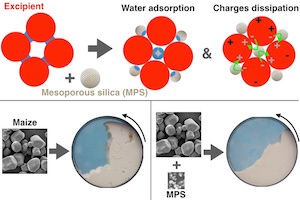
Self assembly processes - My present research project includes a second axis dedicated to the study of self-assembly processes leading to the formation of mesostructures. Mesostructures are microscopic (typically from 100 nanometers to 100 microns) architectures with complex arrangements which confer them remarkable physical properties. Static and dynamic properties of such structures are investigated using model systems of Soft Matter. This activity is based on expertise acquired during my experimental works on collective motions, and patterning in granular materials. These self-organization processes take place in assemblies of micro and nano particles placed in an external field (magnetic and/or electric) and submitted to geometrical, mechanical, capillary and hydrodynamic constraints. In order to identify and to control the relevant self-assembly processes, the interactions between the particles have to be studied precisely. With a better fundamental understanding of these interactions, the self-organization processes will be obtained through a bottom-up method instead of the classical empirical methods. Then, we will be able to improve the long-range organization in mesostructures, catalyst, porous materials, sintered materials, ... Moreover, future studies will be dedicated to reversible self-organized systems where the order could be modified in order to obtain smart reconfigurable materials.
Publications
1. Compaction of anisotropic granular materials: Experiments and simulations
Phys. Rev. E
70, 051314
(2004)
Show Abstract
2. Grain mobility and hexagonal domains formation in 2d granular compaction
Powders & Grains
1, 343
(2005)
Show Abstract
3. Experimental Study of Granular Compaction Dynamics at Different Scales: Grain Mobility, Hexagonal Domains, and Packing Fraction
Phys. Rev. Lett.
95, 028002
(2005)
Show Abstract
| 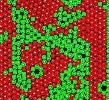 |
|---|
4. Experimental study of the compaction dynamics for two-dimensional anisotropic granular materials
Phys. Rev. E
74, 021301
(2006)
Show Abstract
5. Compaction of granular materials: experiments and contact dynamics simulations
J. Phys.: Conf. Ser.
40, 133
(2006)
Show Abstract
6. Linking compaction dynamics to the flow properties of powders
Appl. Phys. Lett.
89, 093505
(2006)
Show Abstract
7. Precursors to avalanches in a granular monolayer
Phys. Rev. E
74, 031311
(2006)
Show Abstract
8. The influence of grain shape, friction and cohesion on granular compaction dynamics
Eur. Phys. J. E
22, 241
(2007)
Show Abstract
9. Kinetic Energy Fluctuations and Diffusivity in a 2D Vibrated Granular Packing
TRAFFIC AND GRANULAR FLOW 2007
, 597
(2007)
Show Abstract
10. TUNABLE RANDOM PACKINGS
New J. of Phys.
9, 406
(2007)
Show Abstract
11. Swarming and swirling in self-propelled polar granular rods
Phys. Rev. Lett.
100, 058001
(2008)
Show Abstract
|  |
|---|
12. Stationary states in 1D system of inelastic particles
Ukr. Journ. Phys.
53, 1128
(2008)
Show Abstract
13. Controlled flow of Smart Powders
Phys. Rev. E
78, 061302
(2008)
Show Abstract
14. Mullite coatings on ceramic substrates: stabilisation of Al2O3-SiO2 suspensions for spray drying of composite granules suitable for reactive plasma spray
J. of Eur. ceramic soc.
29, 2169
(2008)
Show Abstract
15. Motion of carbon nanotubes in a rotating drum: The dynamic angle of repose and a bed behavior diagram
Chem. Eng. J.
146, 143
(2009)
Show Abstract
16. Packing fraction and compaction dynamics of magnetic powders
AIP Conf. Proc.
1145, 131-134
(2009)
Show Abstract
17. Flow properties and heap shape of magnetic powders
AIP Conf. Proc.
1145, 135-138
(2009)
N. Vandewalle & G. Lumay
The flow properties of powders are mainly related to the interplay of cohesive forces and intergrain frictional forces. Indeed, the formation of large aggregates and the presence of arches modify the dynamic and the static properties of a powder. We have experimentally investigated a "smart powder" for which the interparticle interaction can be tuned by an external magnetic field. Through our experimental results, we show that the rheological and the static properties of such a system can be controlled. (i) Different dynamical flowing regimes have been observed through the output of funnel like a "dry liquid state" forming conic droplets as well as a "layered soft state". (ii) The morphology of a cohesive heap have been also analyzed. The increase of the heap height h with the applied magnetic field strength has been measured for different orientations of the field. Moreover, a strong anisotropy of the heap shape is observed when the magnetic field is oriented perpendicularly to the gravity.
Hide Abstract
18. Compaction dynamics of a magnetized powder
Phys. Rev. E
80, 041302
(2009)
Show Abstract
19. Effect of an electric field on an intermittent granular flow
Phys. Rev. E
81, 041309
(2010)
Show Abstract
20. Compaction dynamics of wet granular assemblies
Phys. Rev. Lett.
105, 048001
(2010)
Show Abstract
21. Flow of magnetized grains in a rotating drum
Phys. Rev. E
82, 040301(R)
(2010)
Show Abstract
22. A pendulum test as a tool to evaluate viscous friction parameters in the equine fetlock joint
The Veterinary Journal
188, 204
(2011)
Show Abstract
23. Influence of a reduced gravity on the volume fraction of a monolayer of spherical grains
Phys. Rev. E
84, 041305
(2011)
Show Abstract
24. Granular gas in a periodic lattice
Eur. Phys. J. E
32, 1465
(2011)
Show Abstract
25. Measuring the flowing properties of powders and grains
Powder Technology
224, 19
(2012)
Show Abstract
26. How relative humidity affects random packing experiments
Phys. Rev. E
85, 031309
(2012)
Show Abstract
27. Hysteretic behavior in three-dimensional soap film rearrangements
Phys. Rev. E
83, 021403
(2011)
Show Abstract
28. Symmetry breaking in a few-body system with magnetocapillary interactions
Phys. Rev. E
85, 041402
(2012)
Show Abstract
29. Cascade of flows for characterizing segregation of granular mixtures
Powder Technology
234, 32
(2013)
Show Abstract
30. Breaking arches with vibrations: the role of defects and friction
Phys. Rev. Lett.
109, 068001
(2012)
Show Abstract
31. Flow abilities of powders and granular materials evidenced from dynamical tap density measurement
Powder Technology
235, 842
(2013)
Show Abstract
32. Experimental study of a vertical column of grains submitted to a series of impulses
European Physical Journal E
36, 16
(2013)
Show Abstract
33. Influence of the gravity on the discharge of a silo
Granular Matter
15, 263
(2013)
Show Abstract
. Self-assembled magnetocapillary swimmers
Soft Matter
9, 2420
(2013)
Show Abstract
35. Melting of a confined monolayer of magnetized beads
Phys. Rev. E
87, 062201
(2013)
Show Abstract
36. Mesoscale structures from magnetocapillary self-assembly
Eur. Phys. J. E
36, 127
(2013)
Show Abstract
37. Customizing mesoscale self-assembly with three-dimensional printing
New J. of Phys.
16, 023013
(2014)
Show Abstract
38. Quantitatively mimicking wet colloidal suspensions with dry granular media
Scientific reports
5, 10348
(2015)
Show Abstract
39. Bernal random loose packing through freeze-thaw cycling
Phys. Rev. E
92, 010202
(2015)
Show Abstract
40. Rheological behavior of β-Ti and NiTi powders produced by atomization for SLM production of open porous orthopedic implants
Powder Technology
283, 199
(2015)
Show Abstract
41. Linking flowability and granulometry of lactose powders
International Journal of Pharmaceutics
494, 312
(2015)
Show Abstract
. Remote control of self-assembled microswimmers
Scientific reports
5, 16035
(2015)
Show Abstract
43. Flow of magnetic repelling grains in a two-dimensional silo
Papers in Physics
7, 070013
(2015)
Show Abstract
44. Ribbons of superparamagnetic colloids in magnetic field
The European Physical Journal E
39, 47
(2016)
Show Abstract
45. Statics and dynamics of magnetocapillary bonds
Phys. Rev. E
93, 053117
(2016)
Show Abstract
46. Effect of relative air humidity on the flowability of lactose powders
Journal of Drug Delivery Science and Technology
35, 207
(2016)
Show Abstract
47. Magnetoelastic instability in soft thin films
The European Physical Journal E
40, 29
(2017)
Show Abstract
48. Relating Brownian motion to diffusion with superparamagnetic colloids
American Journal of Physics
85, 265
(2017)
Show Abstract
49. Frustrated crystallization of a monolayer of magnetized beads under geometrical confinement
Phys. Rev. E
95, 062120
(2017)
Show Abstract
50. Self-assembly processes of superparamagnetic colloids in a quasi-two-dimensional system
Phys. Rev. E
96, 012608
(2017)
Show Abstract
51. Superparamagnetic colloids in viscous fluids
Scientific Reports
7, 7778
(2017)
Show Abstract
52. Self-assembly of smart mesoscopic objects
The European Physical Journal E
40, 108
(2017)
Show Abstract
53. Discharge of repulsive grains from a silo: experiments and simulations
EPJ Web of Conferences
140, 03089
(2017)
Show Abstract
54. Combined effect of moisture and electrostatic charges on powder flow
EPJ Web of Conferences
140, 13009
(2017)
Show Abstract
55. Transitional bulk-solutal Marangoni instability in sessile drops
Phys. Rev. E
98, 062609
(2018)
Show Abstract
56. Remote-controlled deposit of superparamagnetic colloidal droplets
Phys. Rev. E
98, 062608
(2018)
Show Abstract
57. Decompaction of wet granular materials under freeze-thaw cycling
Phys. Rev. E
99, 012901
(2019)
Show Abstract
58. From jamming to fast compaction dynamics in granular binary mixtures
Scientific Reports
9, 7281
(2019)
Show Abstract
59. Tribo-electrification of pharmaceutical powder blends
Particulate Science and Technology
37, 1020
(2019)
Show Abstract
60. How to gain a full understanding of powder flow properties, and the benefits of doing so
ONdrugDelivery
102, 42
(2019)
Show Abstract
61. Influence of mesoporous silica on powder flow and electrostatic properties on short and long term
Journal of Drug Delivery Science and Technology
53, 101192
(2019)
Show Abstract
62. Combined effects of Marangoni, sedimentation and coffee-ring flows on evaporative deposits of superparamagnetic colloids
Colloid and Interface Science Communications
32, 100198
(2019)
Show Abstract
63. Effect of volume fraction on chains of superparamagnetic colloids at equilibrium
European Physical Journal E
42, 123
(2019)
Show Abstract
|

